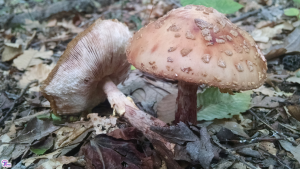#231: Hypholoma tuberosum
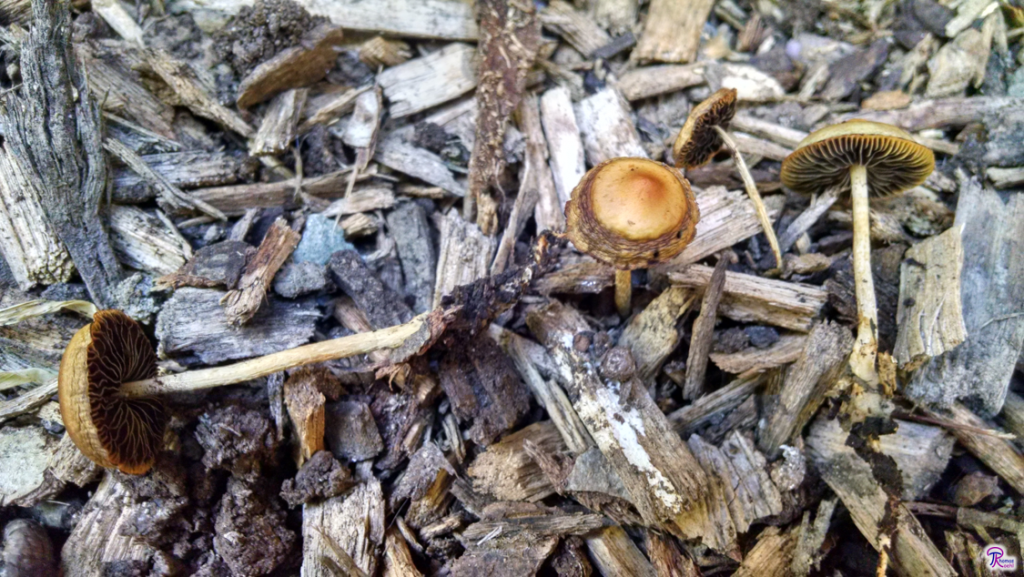
I first saw this mushroom in 2017 at a foray in Pennsylvania. There wasn’t much out, so six of us spent a lot of time trying to identify these little brown mushrooms growing in mulch right outside the foray center. We ruled out everything in our keys and couldn’t nail down the species until we found sclerotia growing below the mushrooms. As it turns out, the sclerotia are the only interesting feature of these LBMs. Brown cap, brown stalk, dark spores, small, growing in mulch – this description could apply to hundreds of mushrooms until you get into the nitty-gritty details. Fortunately, you can easily separate these mushrooms from similar ones by looking for the sclerotia.
Description
Hypholoma tuberosum is a little brown mushroom that grows in mulch beds and other cultivated habitats. It is an umbrella-like agaric with a skinny central stipe and a circular pileus. The mushroom is small to medium in size and all its surfaces are brown, putting it in the frustrating category of “little brown mushrooms” (LBMs).1,2
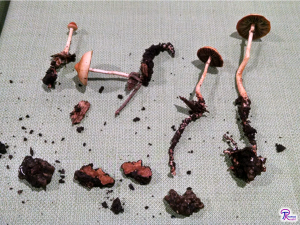
The pileus grows 1.5-4.5cm across and starts out conical but ends up convex to bell-shaped. The center of the pileus is usually topped with an umbo.1,2 I find the pileus is usually flattish around the umbo but downturned near the margin – the same shape as the spaceship from The Day the Earth Stood Still. Throughout development, the pileus is light brown; some specimens are orangey-brown, others are yellowish-brown, and others are just brown. When fresh, the cap is covered with scattered scales (you have to look close for these, but it helps that they sparkle slightly), but these disappear with age. The margin is lighter – typically looking more yellowish or whitish – and often has fibers on it from the partial veil.1,2
Underneath the pileus, the gills radiate out from the central stipe. The gills are attached and start out whitish but become grey to purple-grey as spores mature. The gill margin is slightly fuzzy but otherwise unremarkable. A spore print reveals the spores are dark purple-brown.1,2
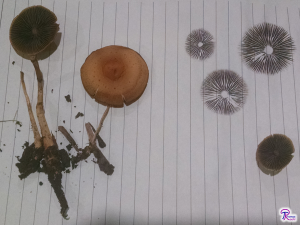
The stipe is unremarkable: long but thin, brown, and with a ring zone. The stipe grows 3-8cm tall, but only 0.2-0.4cm wide. Its width is consistent from the base to the tip and it is straight (sometimes with a few small kinks). The stipe is brownish; the exact color varies but typically matches the color of the pileus. There is a ring zone near the tip that darkens as spores get stuck in it. The stipe is covered in tiny fibers, although the fibers are not very noticeable at first. However, as the mushroom ages, the fibers get thicker and darker starting at the base and progressing up.1,2
The most distinctive part of the mushroom is found below ground. The sclerotia may be attached directly to the base of the stipe or buried up to 15 cm underneath the mushrooms. If the mushrooms are not directly attached to a sclerotium, they produce root-like structures (called “pseudorhiza”) that extend from the base of the mushroom down through the soil until they connect to a sclerotium.1,2 Both times I dug up the sclerotia they were buried deep in the soil and it took some patience and care to excavate the pseudorhiza and find the sclerotia.
H. tuberosum produces sclerotia that are usually shaped like bumpy ovals and can grow up to 5cm across. They look a little like tiny potatoes but are more irregular and bumpier. The sclerotia are brown on the outside and orange-brown to pinkish inside.1,2 The inside is not homogenous, but marbled with different shades. They are very firm (firmer than a potato) but still cut smoothly.
Ecology
As far as we know, H. tuberosum is native to Australia.1–3 It was first identified in a garden in British Columbia, Canada, but investigation later revealed it had been imported from Australia on peat in potted plants.4 Since its discovery in Canada, the mushroom has been found in artificial habitats including mulch beds, lawns, and compost.1,2 In Canada, it has also been found in areas that have loose soil and lots of rodent burrows.1 I’ve found this mushroom twice in mulch and I think I saw it or a picture of it two other times, also in mulch. H. tuberosum is clearly a decomposer, but I haven’t seen any reports on it from the wild, so it’s unclear what its natural ecological role is.
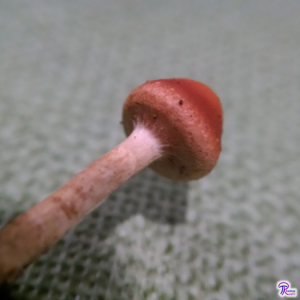
H. tuberosum can now be found in human-influenced habitats across the world – it is recorded from Canada, the United States, several European countries, Japan, China, and Australia.1,2 In North America, it has been recorded from the Pacific coast (British Columbia, Washington, Oregon, and California), and scattered areas in the eastern half of the country (New York, New Jersey, Pennsylvania, Virginia, Ohio, Indianapolis, and Michigan).5,6 Additionally, I saw mushrooms that I’m pretty sure were H. tuberosum along a street in Wisconsin and in a photo from Washington, DC. I tend to find the mushrooms in the fall (September to October).
The mushroom’s range is likely wider than described above because most people – even mycologists –don’t bother recording LBMs. Its widespread range could indicate that H. tuberosum is being spread by mulch companies, much like stinkhorns. Even though it’s widespread in the United States, I don’t see it very often; it’s certainly less common than the other mulch-associated mushrooms like stinkhorns (FFF#190) and Wine Caps (FFF#193). The fact that the mushroom hasn’t been recorded from the Rocky Mountains or most of the Midwest indicates that it was probably introduced to the United States at least twice, once on each coast. Unfortunately, records of this mushroom aren’t good enough to really understand when it was introduced or how it is spreading. As always, you can help with this by taking pictures and uploading them to iNaturalist or Mushroom Observer!
Similar Species
Many species look similar to this little brown mushroom. With most of those, we say, “Just another LBM” and toss them aside. Unless there’s something distinctive about it, you won’t have much luck identifying LBMs because they aren’t covered in field guides and usually require microscopic examination.
There are also other mushrooms that produce sclerotia in mulch. I don’t know of a key to sclerotia (there aren’t very many features you could use to make a key in the first place), so you can’t identify fungi based on the sclerotia alone.
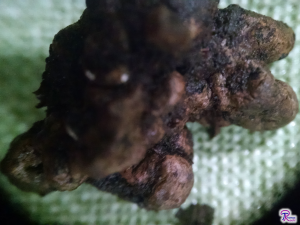
It is worth noting that H. tuberosum does not look like many other fungi in Hypholoma. Hypholoma species typically grow in clusters (think Brick Caps – FFF#125 – or the Sulfur Tuft), so the solitary H. tuberosum seems out of place in the genus. H. tuberosum does have the dark purple-brown spore print characteristic of Hypholoma, but that is pretty much the only clue to its genus.
The un-Hypholoma-like appearance of H. tuberosum caused us problems when we were trying to ID the weird LBMs we found in 2017. After going through Pholiota, Psathyrella, Psilocybe, Stropharia, etc. I finally suggested we try Hypholoma out of desperation. The professional mycologist on site thought this was a waste of time because “Hypholoma never grows singly like that.” Later on, we dug for the sclerotia and confirmed it as H. tuberosum. I relate this story not to make fun of or embarrass mycologists, but because it taught me a valuable lesson: never say never in mycology. Fungi are so diverse that nearly every rule you create to define them has an exception. I like to say, “The first rule of mycology is: there is always an exception to the rule.”
Edibility
I have no information on the edibility of H. tuberosum. Hypholoma contains both edible and poisonous species, so it’s best to avoid this mushroom.
Taxonomy
H. tuberosum belongs in the genus Hypholoma and family Strophariaceae.7 Strophariaceae also includes the genera Pholiota, Stropharia, and Psilocybe.8 For the most part, these are mushrooms with dark spores that grow in manure, well-rotted wood, leaf litter, and mulch.9,10 In terms of morphology and ecology, this mushroom is in good company.
| Kingdom | Fungi |
| Subkingdom | Dikarya |
| Division | Basidiomycota |
| Subdivision | Agaricomycotina |
| Class | Agaricomycetes |
| Subclass | Agaricomycetidae |
| Order | Agaricales |
| Family | Strophariaceae |
| Genus | Hypholoma |
| Species | Hypholoma tuberosum Redhead & Kroeger7 |
See Further:
https://www.mushroomexpert.com/gilled_dark.html
http://www.svims.ca/council/Stroph.htm
https://www.researchgate.net/publication/207537743_Hypholoma_tuberosum_a_new_representative_of_the_Czech_and_Central-European_mycobiota
https://www.researchgate.net/publication/278211891_The_occurrence_of_Hypholoma_tuberosum_Agaricales_Strophariaceae_in_Japan
https://botanicalgarden.ubc.ca/b-c-s-invasive-mushrooms/
Citations
- Antonín, V., Polčák, J. & Tomšovský, M. Hypholoma tuberosum, a new representative of the Czech and Central-European mycobiota. Mycotaxon 108, 41–47 https://www.ingentaconnect.com/content/mtax/mt/2009/00000108/00000001/art00007?crawler=true (2009).
- Nagasawa, E., Shimono, Y. & Hongo, T. The occurrence of Hypholoma tuberosum (Agaricales, Strophariaceae) in Japan. Reports of the Tottori Mycological Institute (Japan) https://www.researchgate.net/publication/278211891_The_occurrence_of_Hypholoma_tuberosum_Agaricales_Strophariaceae_in_Japan (2000).
- Kroeger, P. Trial Keys to purple to blackish spored STROPHARIACEAE of British Columbia, Canada. http://www.svims.ca/council/Stroph.htm (2009).
- B.C.’s invasive mushrooms. UBC Botanical Garden https://botanicalgarden.ubc.ca/b-c-s-invasive-mushrooms/ (2019).
- Hypholoma tuberosum. iNaturalist https://www.inaturalist.org/taxa/382686-Hypholoma-tuberosum.
- Occurrence Map for Hypholoma tuberosum Redhead & Kroeger. Mushroom Observer https://mushroomobserver.org/name/map/5330.
- Hypholoma tuberosum. Mycobank http://www.mycobank.org/name/Hypholoma%20tuberosum&Lang=Eng.
- Kuo, M. The Strophariaceae (‘Pholiostrohyphopsilocybe’). MushroomExpert.Com https://www.mushroomexpert.com/strophariaceae.html (2005).
- Kuo, M. The Genus Hypholoma. MushroomExpert.Com https://www.mushroomexpert.com/hypholoma.html (2016).
- Kuo, M. Stropharioid Mushrooms. MushroomExpert.Com https://www.mushroomexpert.com/stropharioid.html (2018).

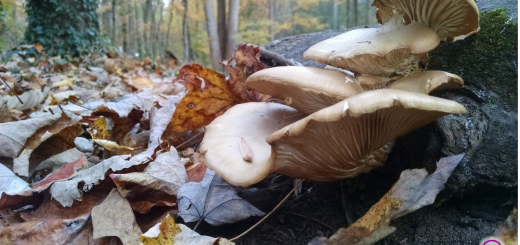

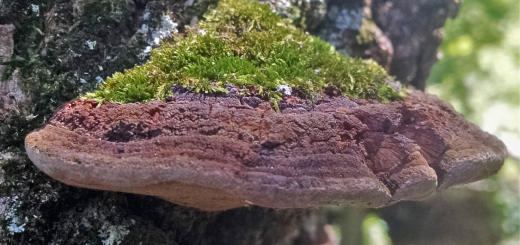





![#011: Characteristics of Kingdom Fungi [Archived]](https://www.fungusfactfriday.com/wp-content/themes/hueman/assets/front/img/thumb-small-empty.png)

